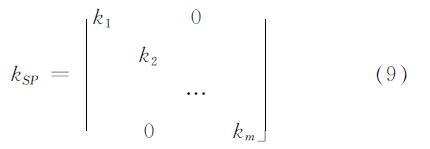基金项目:国家自然科学基金面上项目(41672305); 陕西省重点科技创新团队计划项目(2016KCT-13); 陕西省重点项目(2017ZDXM-SF-078)
第一作者:段 旭(1991-),男,博士生,主要从事土与结构物相互作用方向的研究.E-mail:duanxutim@163.com
(1.西安科技大学 建筑与土木工程学院,陕西 西安710054; 2.陕西科技控股集团有限责任公司,陕西 西安710003; 3.长安大学 地质工程与测绘学院,陕西 西安710054; 4.武警黄金部队第五支队,陕西 西安710100)
(1.School of Architectural and Civil Engineering,University of Science and Technology, Xi'an 710054, China; 2.Shaanxi Science & Technology Holding Group Co.,Ltd., Xi'an 710003, China;3.College of Geological Engineering and Geomatics, Chang'an University, Xi'an 710054, China; 4.No.5 Gold Geological Part of PAP, Xi'an 710100, China)
Loess areas with excavated-filled; piled-raft foundation; model test; uneven settlement
DOI: 10.15986j.1006-7930.2018.03.010
利用自制模型箱,以延安新区黄土挖填方场地中的桩筏基础为原型,开展了相似比为1:5的模型试验.通过上部加载模拟上部结构荷载,对桩体纵筋、筏板表面的应变数据以及桩间土体的土压力数据进行采集分析.试验结果表明,随着上部荷载的增大,地基的不均匀沉降导致了基础产生向填方区的偏转,桩体发生明显的弯曲变形,不同部位桩体的应力集中位置以及桩-土相互作用状态有明显区别.在模型试验的基础上探讨了挖填结合地基上桩-土-筏共同作用的计算式.基础设计时应避免桩体全段位于填方地基中,基桩底部应深入稳定原始土体,并通过对填方地基的预处理提高桩周土体的摩擦力,同时应考虑各桩轴向应变数值以及峰值位置的差异,有针对性地考虑桩体的承载能力.
In this paper, a self-made model box was used to prototype the pile-raft foundation in the loess excavation and filling site in Yan'an New Area, and a model test with a similar ratio of 1:5 was carried out. The loading of the upper structure was simulated by the artificial loading, and the strain data of the longitudinal reinforcement of the piles, the surface of the raft and the soil pressure data of the soil between the piles were collected. The results show that with the increase of the upper load, the uneven settlement of the foundation leads to the deflection of the foundation to the fill area, the pile body undergoes significant bending deformation. There are obvious differences in stress concentration position and pile-soil interaction status of piles at different locations. Based on the model test, the calculation formulas for pile-soil-turbulence interaction on excavation and filling foundations are discussed. The piles should be avoided completely in the fill foundation and the bottom of the pile should be deepened to stabilize the original soil, and the friction of the soil around the pile should be improved through the pretreatment of the fill foundation. The axial strain of each pile should also be considered. The difference between the numerical value and the peak position, with a specific consideration of the bearing capacity of the pile.
随着西部山区建设用地需求越来越大,土地资源日益紧张,黄土地区扩展城市空间的填方造地项目不断涌现.延安新区项目作为黄土地区规模最大的填方造地项目,最大填筑厚度100 m以上,目前已通过填方1.63亿m3,人工造地10.5 km2,有效扩展了延安城市的发展空间.黄土高填方工程填筑高度高,原始地形复杂,不均匀沉降问题备受关注,国内外学者的研究表明高填方的工后沉降发展受填土物理力学性质、初始饱和度、水环境变化等因素的综合影响[1-6].根据笔者在延安新区高填方场地工后沉降的持续监测表明,填方场地地表与填筑体内部深层土体压缩变形量大,挖填结合部位地表表现出较为明显的不均匀沉降[7].
延安新区一期岩土工程部分已基本竣工,目前主要在挖方区中进行工程建设,一方面在等待高填方的沉降稳定,另一方面国内已出现多起由于对填土等软弱地基处理不当导致基础及上部结构变形破坏的案例[8-10],关于在大厚度填方区以及挖填结合区中能否进行建构筑物建设以及应采取何种措施控制变形等问题一直备受争论.
目前,国内对高填方场地中建筑物基础变形破坏机理方面的研究不多,徐欣[11]在对黄土梁峁地区常用基础形式及持力层分析的基础上,根据岩土体工程地质特征对适合作基础持力层的土层作了分析.华遵孟[12]根据实际工程经验,对沟谷地形中黄土高填方场地上的地基处理方法与基础形式的选择问题进行了讨论,提出在挖填改造区场地采用浅基础时的注意事项.吴旭君[13]针对大面积填方的复杂工程地质条件,对天然地基、复合地基等地基基础方案的经济、技术、工期等综合分析和比较,最终采用CFG桩复合地基方案对该区独立基础和条形基础进行计算并设计布桩.桩筏基础方面,国内张武[12]先后进行了一系列非密实砂土、软土中的群桩载荷试验.王幼青等[13]对桩-土-承台的相互作用规律进行了研究.宰金珉[14-15]提出了各具特色的复合桩基设计理论.
综上所述,国内对不均匀地基中桩筏基础的受力及变形状态有一定的研究成果,但针对黄土沟壑地区高填方工程中形成的挖填结合场地,还没有关于桩筏基础的变形受力状态研究.本文通过模型试验针对黄土挖填结合场地建立岩土介质模型,模拟局部伸入挖填结合场地的桩筏基础的变形及受力状态,在此基础上提出变形控制措施,为实际工程提供参考.
为了使模型试验反映工程实际情况,在模型试验的设计中要尽量体现试验原型的应力—应变关系及其变形破坏规律、特征.目前,模型试验设计相关的相似理论的运用已相对较成熟,本文试验模型中各参数均依据相似三定理[17]设计.
根据相似理论,计算得出模型桩筏基础与筏板基础的配筋:桩筏基础中筏板横向配筋为?6@250(双层配筋),纵向配筋为?10@200(双层配筋),灌注桩纵筋为6根?6、箍筋为?3@100; 筏板基础配筋设计与桩筏基础的筏板一致,桩筏基础配筋和筏板基础配筋如图2所示.
3)模型土体材料
延安新区中挖填结合部位通过开挖接坡台阶的工艺进行填筑,在原始坡体中开挖接坡台阶,逐层虚铺0.3~0.8 m后洒水,通过振动碾逐层压实至压实度标准,挖填结合部位采用强夯方法加强填土与原始土体的连结.试验中按照实际工程中的施工工艺,在挖方坡体开挖接坡台阶,每级台阶高50 cm、宽50 cm.采用西安北郊均质黄土人工分层夯实制作,为保证挖方区和填方区地基土的压缩性差异满足要求,对挖方区土体夯击3遍,并静置至其自身沉降稳定(小于0.01 mm/d),填方区土体夯击2遍; 通过室内土工试验,获得的试验场地地层参数见表2.
(1)位移、沉降
为了量测填土顶面和模型基础的沉降,分别在基础周围的地表和基础的四角布设了沉降观测点,桩筏基础模型试验及筏板基础模型试验各设两条测线,位移计布设如图3所示,地面沉降观测点与基础沉降观测点相对应.
(2)应变
(a)钻孔灌注桩主筋应变.试验主要用于结构应力应变研究,因此主要获取其结构的应力应变变化曲线.试验中采用应变片测试主筋应变,如图4所示. 每根桩由距离桩顶0.15 m处开始,每隔0.4 m设置一个测试断面,共设置6个测试断面; 每根桩从桩顶到桩底各测试断面的应变片编号为1-6号,用W、S、E、N分别表示桩的西、南、东、北四个方向的纵向钢筋,其中S为挖方区方向,N为填方区方向.
(b)桩筏基础筏板钢筋应变.等间距选取桩筏基础的筏板纵向钢筋9根布设9条测线,测线编号为测线1至测线9(由东向西); 每条测线等间距布设16个应变片,应变片编号1至16(由南向北),通过对纵筋应变数据的采集、处理、分析,结合位移数据、筏板表面应变数据、筏板表面裂缝情况,研究桩筏基础筏板在挖填地基中的受力及变形破坏特征.
(3)土压力
土压力量测:土压力盒从下到上共布设四层,基础范围内布设横向压力盒,在基础前侧填方区布设竖向压力盒,压力盒布置如图5所示.
(4)加载设计
试验中为了施工方便及加载稳定,全部采用沙袋均匀堆载的方式加载.模基础配重采取沙袋,即把沙袋均匀的堆放到基础上.本次基础加载为面荷载,根据相似关系,桩筏基础最大荷载达到19.6kPa,试验中模型的制作与加载过程见图6.
图7、图8分别为桩筏基础挖方一侧与填方一侧位移数据,可以看出,各级加载过程中,填方区沉降量均大于挖方区,这是由于填方区土体压缩系数大于挖方区土体,相同荷载作用下填方区土体更易发生变形; 最终荷载量19.6 kPa时,桩筏基础在挖方区、填方区沉降差0.62 mm,基础角部竖向位移明显大于周围土体.
(1)筏板纵筋应变分析
在桩筏基础筏板纵向钢筋外表面粘贴应变片,测线1-9对称分布,选取一侧的测线1、2、3、4、5进行处理.由图9(a)—(f)可以看出,筏板上正弯曲应变主要集中在挖填结合区及挖方区,负弯曲应变主要集中在填方区,即筏板在挖方区上侧受拉,填方区下侧受拉,在挖填结合区挖方区侧上侧受拉、填方区侧下侧受拉; 筏板的弯曲应变的最大值主要集中在桩间的区域,最大正向弯曲应变主要集中在填挖结合区内桩B和桩C之间,最大负向弯曲应变主要集中在纯填方区桩A和桩B之间的范围.产生这种现象的原因主要是由于纯填方区土体在上部荷载作用下沉降量明显大于结合区和挖方区,全段位于纯填方区中的桩A得不到足够的桩周摩阻力,随桩周土体同步发生较大的沉降变形,带动桩间筏板产生负向弯曲应变.且桩C和桩B底部伸入稳定的原始土层,承载能力明显强于桩A,导致桩间筏板产生正向弯曲应变.
桩筏基础筏板的弯曲状态与筏板基础的主要区别在于,桩筏基础中筏板的弯曲变形以桩为间隔,并不连续,挖填结合区以及纯填方区内桩间筏板的弯曲变形最为剧烈.筏板基础的弯曲变形主要取决于基础浅部地基的沉降情况,由于填土厚度的梯度变化,挖填结合区内地基土发生不均匀沉降,是筏板基础产生弯曲变形的主要位置.
(2)桩身应变分析
为负则桩身南侧(挖方区方向一侧)受拉,为正则桩身北侧(填方区一侧)受拉,各桩应变曲线图如图 10所示.
从桩身弯曲应变曲线可以看出,各桩身弯曲应变规律基本一致,桩顶部位有较大的负弯曲应变,桩体端部南侧受拉,桩身0.4~1.2 m范围弯曲应变为正,桩身南侧受压. 桩身1.2~2.4 m范围弯曲应变较小且为负值,桩身南侧受拉. 各桩弯曲应变桩A(填方区)>桩B(挖填结合区,填土厚度1.5 m)≈桩D(挖方区)>桩C(挖填结合区,填土厚度0.5 m).基础和地基土在填方区的沉降量比挖方区大,基础存在水平位移,桩体与筏板基础为刚性连接,因此各桩桩顶产生较大负弯矩; 桩C处于挖填结合区,桩体填土厚度小,桩体受地基不均匀沉降影响小,桩B和桩D可对桩C分担弯矩,因此桩C弯矩较小.
从桩身轴应变曲线可以看出,各桩轴应变沿桩身从桩顶至桩底呈现先增大后减小趋势,桩底基本为零; 荷载量的增加,各位置轴应变增大; 各桩轴应变量桩B最大,桩A最小,这是因为填方区土体密实度小,桩A端承力小,地基土可提供侧摩阻力小,而与桩A临近的挖填结合区桩B桩底为挖方区土层,土体密实度较好,能够较好低为其承担上部荷载,因此桩B轴应变较大; 对比桩轴应变曲线可以看出,均匀土体中桩轴应变集中在距桩顶0~1.4 m范围内较大,且沿桩身轴应变减小速率大,而挖填结合区桩B、桩C轴应变集中在距桩顶0~1.8 m范围内较大,沿桩身轴应变较小速率小.
压力盒位置如图5所示,其中1-8号均为横向压力盒,布设于相邻两桩中间位置,用于监测桩间土的竖向压力; 9-12为竖向压力盒,布设于桩筏基础填方区前缘,用于堆载过程中的坡体水平推力.
(1)竖向土压力分析
图 11为横向压力盒土压力变化曲线,未加载前地基土压力设为零值,由图可知,桩筏基础下地基土压力随基础上部荷载量的增加而增大,说明桩筏基础筏板上部荷载由桩间土和桩体共同承担; 最终荷载量19.6 kPa时,挖方区和挖填结合区桩底土压力(第一层)比上层土压力大,在填方区桩底土压力比上层小,其中桩B桩底土压力最大,桩A桩底土压力最小,这与桩B轴应变最大、桩A轴应变最小相印证.
(2)水平土压力分析
图 12为竖向压力盒土压力变化曲线,由图 12(a)—(b)竖向压力盒10、12土压力变化曲线可以看出,基础前端土压力在顶层和底层增加量较大,中间两层增加量小,最终荷载19.6 kPa时坡顶所受水平推力最大,这是受桩筏基础加载后产生水平位移的影响; 对于基础前端基础范围外,整体土压力增加量较小,距基础表面1.0 m处土体所受水平推力最大.
在试验结束后开挖剖面对土体和结构物的裂缝破坏形态进行描绘,如图 13所示,土体破坏主要集中在桩筏基础边界位置,桩体周围和挖填结合面附近; 挖方区筏板基础边界裂缝F1和F2竖向长度约为60~105 cm,受基础边界效应的影响,发生剪切破坏,基础边界附近与桩体表面夹角约30°,下部基本呈竖直方向; 挖填结合面附近土体裂缝较多,裂缝F5- F7和裂缝F9、F10均为挖填结合面附近裂缝,主要集中在结合面二三级台阶拐角处,土体受到剪切和张拉破坏,裂缝长度20~60 cm,竖直方向; 填方区土体裂缝集中在筏板基础边界处,与挖方区位置基本对应,裂缝F13、F14长约40 cm,与土体垂直; 桩间土体裂缝F8摩擦,降低基桩的承载力,加剧基础的不均匀沉降.基础端部土体由地表开始发育数条垂直向裂缝,伸入地基深处,成为地表水分的垂直入渗的路径,而延安新区中填土与原始黄土地基均具有一定的湿陷特性,地表水分的大量入渗将导致地基土体的湿化变形,影响挖填方场地的整体稳定.接坡台阶部位原始土体中出现6条垂直方向剪切裂缝,明挖填结合面处,原始土体承受着较大的压、剪应力,当剪应力超过土体的抗剪强度,接坡台阶处的原始土体将发生破坏,直接影响挖填方场地的稳定.
在文克尔地基梁模型的基础上,考虑挖填结合区填方土体与原始土体各自的基床系数,将桩体简化为弹簧体系,构建适用于挖填结合区地基条件的力学模型.
对于桩筏基础在挖填结合区的受力状态如图 14所示.可将桩与桩间土体视为彼此独立的竖向基床:桩间土的基床系数为ksi; 桩的弹簧系数为kPi,其作用力可通过F=kx获得.在荷载作用下,区域内产生与压力成正比的沉降,区域外位移为零,位移x为协调条件.
将筏板下的地基在平面上划分为m个矩形网格,矩形网格尺寸的大小与桩径相近.取出每个网格柱进行力学分析,每个网格柱的高度与桩长相等,将网格柱视为拉压构件,进而确定其压缩系数.得出填土部分的基床系数为
ksi1=Es1A/L1(5)
原始土体部分的基床系数:
ksi2=Es2A/(L-L1)(6)
挖填结合区土基床系数ks:
ksi=(ksi1ksi2)/(ksi1+ksi2)(7)
式中:Es1为填方土体压缩模量,Es2为原始土体的压缩模量,L1为填方土体平均厚度.
在网格划分时,出现网格中既有填方区又有挖方区的情况时网格的基床系数可视为并联关系,网格内土体的基床系数为
km=ksi1+ksi2(8)
其中:ksi1、ksi2分别为网格内填土与原始土体的基床系数.
得出桩、填土、原始土、挖填结合区土体的基床系数矩阵后,可以求解出地基土中m个网格的基床系数为ks1、

根据文克尔地基模型的统一表达式{R}=[KSP]{S},可得

文克尔地基模型中基础与地基保持位移协调的关系,核心问题是建立桩-土-地基和筏板的系数矩阵,上文已得出桩与地基的联合系数矩阵,结合筏板的系数矩阵,可以得出共同作用基本方程表达式,即挖填结合地基上桩-土-筏共同作用的计算式:
{[Kr]+[KSP]}[U]=[f](11)
其中:[Kr]为筏板自身系数矩阵; [KSP]为桩土地基系数矩阵; [U]为筏板节点位移矩阵; [f]为筏板上部结构荷载节点力矩阵.
通过开展模型试验,对黄土挖填结合部位桩筏基础在加载过程中的变形-破坏的过程进行模拟,综合分析应变、位移、土压力数据,得出以下主要结论:
(1)在文克尔地基梁模型的基础上,考虑挖填结合区填方土体与原始土体各自的基床系数,将桩体与桩间土简化为不同k的弹簧体系,构建了适用于挖填结合区地基条件的筏板基础和桩筏基础的力学模型.
(2)基础设计时应避免桩体全段位于填方地基中,基桩底部应深入稳定原始土体,并通过对填方地基的预处理提高桩周土体的摩擦力,同时应考虑各桩轴向应变数值以及峰值位置的差异,有针对性地考虑桩体的承载能力.
(3)根据模型试验结果,不建议在挖填结合区内布设建筑物,但是当无法避开挖填结合区时,对跨越黄土挖填方场地的筏板基础和桩筏基础的设计、施工提出以下建议:①桩筏基础跨越挖填结合区时,应对基础范围内的填土进行预处理,防止负摩阻力的产生; ②纯填方区内的桩体应增大桩径或减少桩间距,局部可增加配筋,提高抗弯刚度; ③挖填结合区中的桩体在设计中应充分考虑水平承载力,试桩后应进行水平承载力试验.